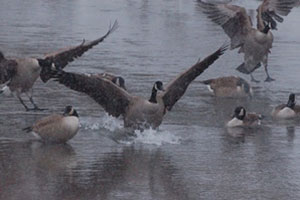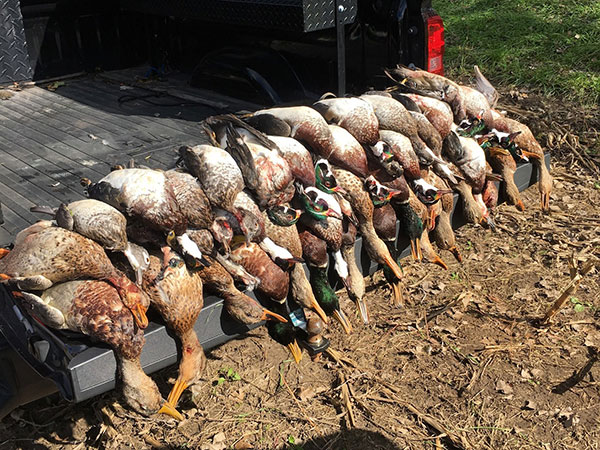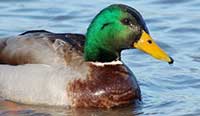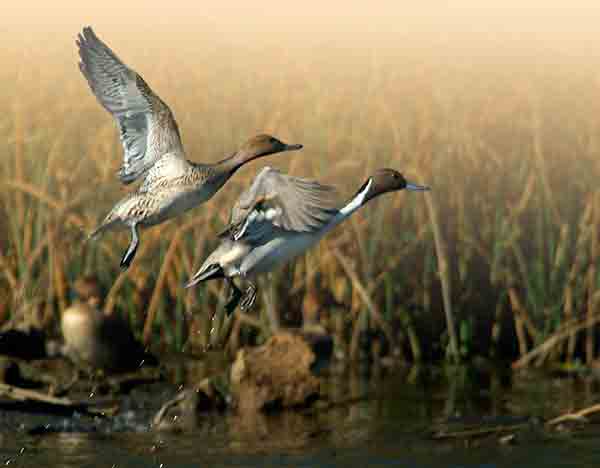- Details
(Provided by MDNR)
 Muskegon County Wastewater System Offers Excellent WaterfowlingWhen many think of wastewater facilities, they think of smelly, unpleasant areas unfit for humans. Hunters and birders know that Muskegon County Wastewater System is something special. With large storage lagoons and 3,500 acres of agriculture habitat, Muskegon County Wastewater managed waterfowl hunt area produces excellent habitat for both ducks and geese.†
Muskegon County Wastewater System Offers Excellent WaterfowlingWhen many think of wastewater facilities, they think of smelly, unpleasant areas unfit for humans. Hunters and birders know that Muskegon County Wastewater System is something special. With large storage lagoons and 3,500 acres of agriculture habitat, Muskegon County Wastewater managed waterfowl hunt area produces excellent habitat for both ducks and geese.†
Canada geese are plentiful at the Muskegon County Wastewater and are one of the most harvested species. Opportunities for snow, Rossís and cackling geese sometimes occur. During the regular waterfowl season, hunters commonly take mallards, black ducks and other dabblers.
- Details
(Provided by MDNR)
 Poachers Nabbed for Killing 60 Ducks
Poachers Nabbed for Killing 60 Ducks
Four Ottawa County men were ticketed recently for poaching nearly 60 wild ducks from a private agricultural pond near the Grand River watershed, an area popular for waterfowl hunting.
The names of the four Coopersville area men, who range in age from 20 to 24, are being withheld, pending their scheduled Oct. 26 appearance in Ottawa County District Court in Hudsonville.
"This was not hunting," said conservation officer Dave Rodgers. "Hunting involves a lot of hard work and fair chase. What these guys were doing is killing."
At 7:38 a.m. Oct. 9, operators of the Michigan DNR Report All Poaching (RAP) line received a call reporting an immense amount of shooting during this past weekend's opening of the South Zone waterfowl hunting season.
Minutes later, Rodgers and conservation officer Chris Simpson responded, headed for Chester Township in north Ottawa County.
Rodgers said he found the four men on private property along an agricultural pond. He allegedly saw them shooting at crippled ducks on the water and gathering them.
Rodgers next spoke to the men.
- Details
(Provided by IDNR)
The hunting season dates for waterfowl and other migratory birds in Indiana have been finalized.
The U.S. Fish and Wildlife Service accepted the dates as proposed, with no changes.
The season dates for webless migratory game birds are:
- Mourning doves: Sept. 1 to Oct. 16, Nov. 1-13, and Dec. 10 to Jan. 8.
- Sora rails: Sept. 1 to Nov. 9.
- American woodcock: Oct. 15 to Nov. 28.
- Common snipe: Sept. 1 to Dec. 16.
The daily bag limits for webless migratory birds are 15 mourning doves, 25 sora rails, three woodcock and eight snipe. Possession limits are three times the daily bag limits.
- Details
(Provided by MDNR)
 Michigan’s 2016-17 Waterfowl Season Dates AnnouncedIt's almost time to polish up the shotgun, warm up the retriever with some practice throws and don camouflage as the season nears for hunting ducks and geese in Michigan. Area wildlife managers have been working hard all summer to make sure migrating waterfowl have great habitat conditions in Michigan's state game and wildlife areas this fall.
Michigan’s 2016-17 Waterfowl Season Dates AnnouncedIt's almost time to polish up the shotgun, warm up the retriever with some practice throws and don camouflage as the season nears for hunting ducks and geese in Michigan. Area wildlife managers have been working hard all summer to make sure migrating waterfowl have great habitat conditions in Michigan's state game and wildlife areas this fall.
Waterfowl hunting [ http://www.michigan.gov/dnr/0,4570,7-153-10363_10859---,00.html ]regulations and bag limits can be found in the 2016-2017 Michigan Waterfowl Hunting Digest.
- Details
(Provided by IDNR)
 Indiana Announces 2016 Migratory Bird and Waterfowl Hunting Season Dates
Indiana Announces 2016 Migratory Bird and Waterfowl Hunting Season Dates
The hunting season dates for waterfowl and other migratory birds, as proposed to the United States Fish and Wildlife Service (USFWS) by the Indiana DNR, are listed below.
The dates are not final unless approved by the USFWS in July. A later announcement will either confirm or amend these dates. Historically, they have been accepted as proposed.
Beginning this year, the federal regulatory cycle has been altered. Rather than two separate processes for early and late seasons, all migratory bird hunting seasons are selected together. The seasons are based on population and habitat data gathered the year before. Therefore, the 2016-17 hunting seasons are based on the same data used to set the 2015-16 seasons, and the biological data currently being collected will be used to set next year's seasons.
The DNR's recommended dates for webless migratory game birds are:
- Mourning doves: Sept. 1-Oct. 16, Nov. 1-13, and Dec. 10 to Jan. 8
- Sora rails: Sept. 1 to Nov. 9
- American woodcock: Oct. 15 to Nov. 28
- Common snipe: Sept. 1 to Dec. 16.
The daily bag limits for webless migratory birds are 15 mourning doves, 25 sora rails, three woodcock and eight snipe. Possession limits are three times the daily bag limits.
The DNR's recommended dates for ducks, coots and mergansers are:
Early teal (blue- and green-winged only, statewide):
- Sept. 3-18.
Regular waterfowl seasons:
- North Zone: Oct. 22 to Dec. 11, and Dec. 24 to Jan. 1
- Central Zone: Oct. 29 to Nov. 6, and Nov. 19 to Jan. 8
- South Zone: Oct. 29 to Nov. 6, and Nov. 26 to Jan. 15.
The daily bag limit for ducks in all zones is six, including no more than four mallards (of which no more than two can be hens), three scaup, three wood ducks, two pintails, two redheads, two canvasbacks, one black duck and one mottled duck. The daily bag limit for coots is 15. The daily bag limit for mergansers, separate from ducks, is five, of which no more than two can be hooded mergansers. The possession limit is three times the daily bag limit.
For Canada geese, white-fronted geese, brant and light geese, the proposed dates are:
- North Zone: Sept. 3-11, Oct. 22 to Nov. 20, and Dec. 10 to Feb. 12
- Central Zone: Sept. 3-11, Oct. 29 to Nov. 6, and Nov. 19 to Feb. 12
- South Zone: Sept. 3-18, Oct. 29 to Nov. 6, and Nov. 26 to Feb. 12.
The bag limit is five dark geese (Canada, white-fronted and brant in aggregate), no more than three of which can be Canada geese. The bag limit in September is five dark geese, all of which can be Canada geese. The possession limit is three times the daily bag limit. The daily bag limit for light geese (snow, blue and/or Ross' geese) is 20, with no possession limit for light geese. The proposed light goose conservation order is Feb. 13 to March 31, statewide.
The light goose conservation order has no bag or possession limit. A free permit is required. Details will be available later in the winter.
The DNR's recommended dates for youth waterfowl season are:
- North Zone: Oct. 15-16
- Central Zone: Oct. 22-23
- South Zone: Oct. 22-23.
Bag and possession limits are the same as the regular seasons. The youth waterfowl season is open to youths age 15 and younger, accompanied by an adult.
Ducks, coots and mergansers:
- North Zone: Sept. 27-30, and Feb. 14 to March 10
- Central Zone: Oct. 22-28, and Feb. 17 to March 10
- South Zone: Oct. 22-28, and Feb. 17 to March 10.
American woodcock:
- Sept. 20 to Oct. 14, and Nov. 29 to Jan. 4
Mourning doves:
- Oct. 17-31 and Jan. 9-11
The bag limit is three migratory birds singly or in aggregate. The possession limit is nine migratory birds singly or in aggregate.
For more information, contact Adam Phelps, DNR Division of Fish & Wildlife, (812) 334-1137, or aphelps@dnr.IN.gov




